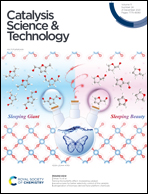Photocatalytic green synthesis of benzazoles from alcohol oxidation/toluene sp3 C–H activation over metal-free BCN: effect of crystallinity and N–B pair exposure†
Abstract
Porous borocarbonitride (P-BCN), with the characteristics of enhanced crystallinity and improved N–B pair exposure, was prepared with a simple KCl-assisted molten salt strategy. Efficient heterogeneous photocatalytic tandem synthesis of benzazoles from alcohol oxidation/toluene sp3 C–H activation was achieved firstly over the metal-free P-BCN using visible light and the green oxidant O2, with only water as a by-product. Various o-thio/hydroxy/aminoanilines and alcohols or toluenes could be converted to the corresponding 2-substituted benzothiazoles, benzoxazoles and benzimidazoles with good to excellent photocatalytic performance. The improved photocatalytic performance in comparison to bulk BCN should be due to the crystallinity-enhancement-induced improvement in charge separation and transmission. The increased N–B pair exposure promoted superoxide radical generation due to the electron-enriched N atoms, as well as improved oxidation ability due to the valence band constructed by the B 2p orbital. This work presents a green and efficient synthetic strategy towards benzazoles and other fine chemicals via metal-free heterogeneous photocatalysis.



 Please wait while we load your content...
Please wait while we load your content...